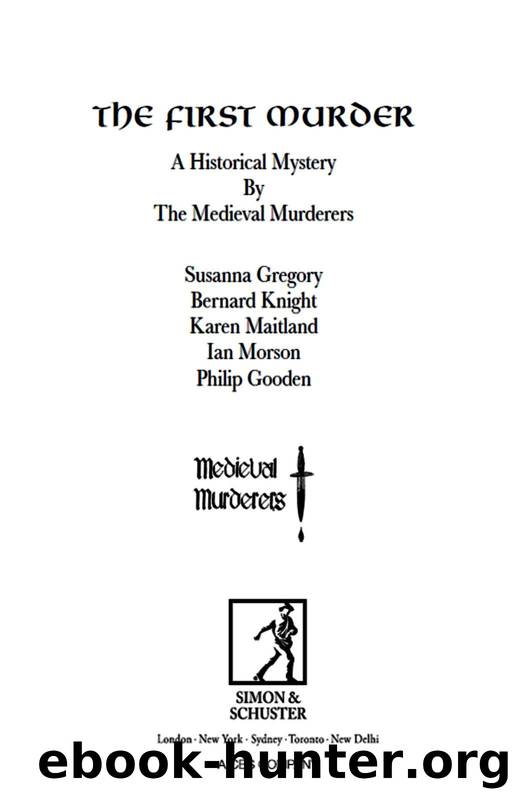The First Murder by Gregory Susanna

Author:Gregory, Susanna [Gregory, Susanna]
Language: eng
Format: epub
ISBN: 9781471102721
Publisher: Simon & Schuster UK
Published: 2012-07-05T00:00:00+00:00
Outside in the darkness a single bell began to toll. Brother Oswin was dead. How many more times would that bell ring over the coming weeks? Whatever Prior Alan chose to believe, Stephen felt a shadow hovering over Ely, darker and more terrifying than any demon. And he knew then with a dreadful certainty that the scroll had been sealed too late â far too late to save them now.
Historical Notes
In the seventh century St Eltheldreda, daughter of Anna, King of East Anglia, founded the monastery of Ely and her youngest sister, Withburga, founded a nunnery at Dereham. Many miracles were attributed to Withburga, including that a wild doe came to her to be milked twice a day to provide food for the workmen who were building the church at Dereham. When she died in around AD 743, she was buried at Dereham, which became a place of pilgrimage.
In 974, Brithnoth, Abbot of Ely, decided that Withburga should be interred in the cathedral along with her sister Etheldreda. The abbot and his monks broke into the shrine at Dereham and stole the saintâs body. In the morning the men of Dereham gave chase, but the body was already on a boat sailing up the river towards Ely. When the Dereham men returned home they found a miraculous spring had welled up in the empty grave. The shrines of the two princesses, together with the shrines of their sister Sexburga and her daughter, Ermengild, made Ely Cathedral an important medieval pilgrimage site, but, sadly, the shrines were destroyed in 1541 during the Reformation.
Relics of saints were widely used to heal the sick, and also in rituals to raise spirits, angels and demons. The sword described in the story was used by priests who had been trained in the art of necromancy and in summoning spirits. Priests would undertake these rituals in the service of the Church, just as others would perform exorcisms. Today such rites would be condemned by most bishops, but in the Middle Ages they were regarded as part of Christian belief and practice, and a number of learned medieval scholars and theologians wrote detailed treatises on these rituals.
The widely held superstition that a dead manâs hand, or âhand of gloryâ, could be used to open any lock, render a thief invisible and put the occupants of the house to be burgled into a deep sleep was still believed as late as the nineteenth century. Indeed, the Observer newspaper of 1831 reports the arrest of a burglar caught using a hand of glory. These hands were normally cut from the corpse of a hanged man, but since they were also believed to have great curative powers, Father Edmund, in his crazed mind, might well have believed he could use the saintâs hand for this purpose, if she failed to cure the plague.
The return of the plague in 1361 affected Cambridgeshire particularly badly, striking many villages and towns that had escaped the first wave in 1348, with devastating results. Although
Download
This site does not store any files on its server. We only index and link to content provided by other sites. Please contact the content providers to delete copyright contents if any and email us, we'll remove relevant links or contents immediately.
Love Your Life by Sophie Kinsella(1001)
Albion by Peter Ackroyd(847)
The Hell of it All by Charlie Brooker(795)
Albion: The Origins of the English Imagination by Peter Ackroyd(709)
How To Be A Woman by Caitlin Moran(690)
A Dictionary of Literary Symbols by Michael Ferber(664)
English Literature: A Very Short Introduction by Jonathan Bate(618)
The Eye in the Triangle: An Interpretation of Aleister Crowley by Israel Regardie(607)
Protector by Conn Iggulden(607)
Dot Con by James Veitch(560)
All in a Don's Day by Mary Beard(512)
English Literature: A Very Short Introduction (Very Short Introductions) by Bate Jonathan(498)
I, Partridge by Alan Partridge(458)
Less: Winner of the Pulitzer Prize for Fiction 2018 by Andrew Sean Greer(458)
The Cambridge Introduction to Jane Austen (Cambridge Introductions to Literature) by Janet Todd(438)
Work! Consume! Die! by Boyle Frankie(431)
Mussolini: His Part in My Downfall by Spike Milligan(427)
I can make you hate by Charlie Brooker(400)
Sir Gawain and the Green Knight; Pearl; by J. R. R. Tolkien(400)
